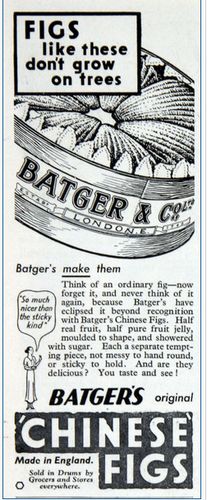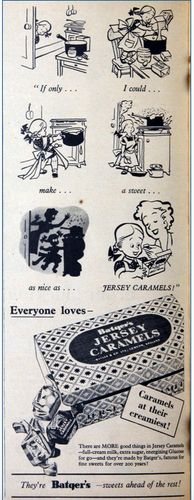The Clapham Society Local History Series — 30
Making Sweets in Clapham
by Alyson Wilson
This article first appeared in the South London Press on 15 September 2017
(Entitled: ‘Sweet taste of success’)

In 1748 Miss Batger, a member of a leading family of sugar refiners, started a confectionery company in East London, which was to be become one of the largest makers of jam and confectionery by the early 20th century. After a few moves and changing hands but retaining the family name, in the mid-19th century the factory moved to Broad Street in Stepney where it remained until the premises were destroyed by bombing in 1940.
In 1875 the factory covered two acres and employed 450 people, which rose to 550 over the Christmas period and 700 in the fruit season when the jam was made. Around 2,000 tons of sugar and 1,000 tons of English fruits were used each year. There was an incident some years later when 24 tons of rotten fruit were seized by the health authorities!

The company continued to grow and had over 1000 employees in the first decade of the 20th century. During the First World War Batgers secured a valuable contract to supply jam to the army. When the Stepney factory was destroyed in 1940 Batgers moved to Clapham, to a site at 44 Clapham Common South Side, which had been occupied by another confectionery company, Cleeves, since the early 1920s. Batgers became well known for several popular lines, in particular Chinese figs, Silmo’s lollies and Jersey Caramels, and their advertisements were imaginative and entertaining. In later years they also made Sainsbury’s own brand sweets, and supplied the bakery trade with cake decorations.
Another product for over 100 years was Harlequin Christmas crackers.
Several Clapham people remember the factory well, some because members of their family worked there, but others because as boys they were at Henry Thornton School which was right next to Batgers. Apparently boys would make regular forays to check for remains of toffee left outside in the trays awaiting cleaning. There was also a memorable day when, to celebrate the end of sweet rationing in February 1953, sweets were handed out to children at the factory gate.


In 1970 Batgers was acquired by the Needler company of Hull, and the Clapham factory closed the next year when all production moved to Hull. Needlers was later sold on to another confectionery company, and production of the last original Batgers line, their famous Chinese Figs, was discontinued in 2000.
For the next few decades 44 Clapham Common South Side was home to several companies, for much of the time OCS (Office Cleaning Services). When they left an ambitious plan was put forward in early 2017 for the demolition of the run-down buildings and development of the four-acre site.
At present planning permission is pending for the development which will comprise six blocks ranging from four to ten storeys high, providing 297 residential units, office accommodation and a café. Landscaped gardens, and a public square are also planned. The site, with only a narrow entrance off Clapham Common South Side, is squeezed between Lambeth College and the Notre Dame Estate, to which it will be linked. One particularly welcome plan is the restoration of the Grade II listed eighteenth century Orangery in the Notre Dame Estate, which has been too long neglected. The scheme proposes a full restoration of the Orangery, a new floor and double hung sash hung windows in the existing original openings, landscaping of a formal garden courtyard and the addition of three rooms at the rear for community use.

Part of the proposed new development of 44 Clapham Common South Side.